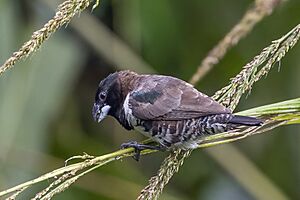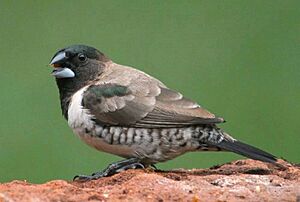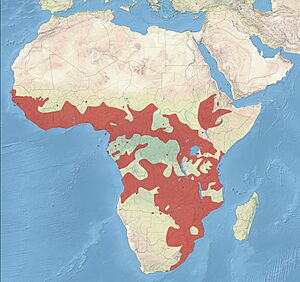Bronze mannikin facts for kids
Quick facts for kids Bronze mannikin |
|
|---|---|
 |
|
| L. c. subsp. cucullata, São Tomé and Príncipe | |
 |
|
| L. c. subsp. scutata in South Africa | |
| Conservation status | |
| Scientific classification | |
| Genus: |
Spermestes
|
| Species: |
cucullata
|
 |
|
| distribution | |
| Synonyms | |
|
|
The bronze mannikin (Spermestes cucullata) is a tiny bird found in Africa. It's also called the bronze munia. This bird is a type of finch and loves to be around other birds. You can find them in many parts of Africa, south of the Sahara Desert. They live in grassy areas or near the edges of forests.
These birds are quite common in many places. They are the smallest of four similar bird species in mainland Africa. The others are the black-and-white mannikin, red-backed mannikin, and magpie mannikin. Bronze mannikins also live on the Comoro Islands. They were even brought to Puerto Rico and now live there too. Sometimes, farmers in West Africa see them as a problem because they eat grains and rice fields. People also sometimes catch them for the pet bird trade.
Contents
About the Bronze Mannikin
How Scientists Name Birds
The bronze mannikin was officially named in 1837. An English scientist named William John Swainson gave it the scientific name Spermestes cucullata. The word cucullata means "hooded" in Latin. This name refers to the bird's dark head, which looks a bit like a hood.
Different Types of Bronze Mannikins
Scientists recognize two main types, or subspecies, of the bronze mannikin:
- S. c. cucullata: This type is found from Senegal and Gambia all the way to South Sudan, Uganda, and West Kenya. It also lives on the island of Bioko.
- S. c. scutata: This type lives from Ethiopia and East Kenya down to Southeast South Africa. You can also find it in East Angola and the Comoro Islands.
What Does a Bronze Mannikin Look Like?
| Measurements | |||
|---|---|---|---|
| Length | 87–92 mm (3.4–3.6 in) | ||
| 85–88 mm (3.3–3.5 in) | |||
| Culmen | 9–10 mm (0.35–0.39 in) | ||
| 8–9 mm (0.31–0.35 in) | |||
| Wing | 48–50 mm (1.9–2.0 in) | ||
| Tail | 30–35 mm (1.2–1.4 in) | ||
| Tarsus | 10–11 mm (0.39–0.43 in) | ||
| 10 mm (0.39 in) | |||
The bronze mannikin is one of the smallest munia birds. It is about 9 to 10 centimeters (3.5 to 4 inches) long. It weighs only 7 to 12 grams, which is about as much as a few paper clips!
Colors and Markings
Adult bronze mannikins are compact birds. They have a short black tail. Their beaks are stubby and black with pale grey parts. Their head, chin, throat, and the middle of their chest are black or brownish-black. These parts can even look a bit purple-green in the light.
Their upper body is grayish-brown. Their belly is white with some wavy lines on their sides and rump. They have a small green shiny patch on their shoulder feathers. The feathers on their wings have lighter edges. Male and female birds look very similar.
Young Birds
Young bronze mannikins look a bit different. They are dull brown on top. Their head and belly are a light tan color. They grow into their adult feathers by about six months old. At this age, the males also start to sing and show breeding behaviors.
Bird Calls and Songs
Bronze mannikins make different sounds. When they fly, they often make a rreep-rreeep sound. When they are sitting, they twitter with various squeaky or buzzing notes. Their song is a long series of notes that repeats a bit.
Where Do Bronze Mannikins Live?
Bronze mannikins are originally from mainland Africa. They also live on several islands. These include Bioko, Pemba, Zanzibar, Mafia, and the Comoro Islands. As mentioned, they were also brought to Puerto Rico and now live there.
There is a large area around the upper Nile River where the two main types of bronze mannikins mix. Birds in this area have features from both types.
How Bronze Mannikins Live Their Lives
The bronze mannikin is a very social bird. They like to live in groups.
What They Eat
These birds mainly eat seeds. This includes seeds from wild grasses, millet, rice, and other grains. Sometimes, they also eat termites, nectar from flowers, or even strands of algae. Before they go to sleep for the night, they usually visit a watering hole. They like places where plants hang into the water.
Their Roosting Habits
At night, they sleep in ball-shaped nests. When it's not breeding season, they build these nests just for sleeping. These nests are often messy. The birds take them apart and rebuild them almost every day. They might build them in the same spot or a new one. This is a group effort!
A group of 8 to 20 birds usually has one adult male that seems to be in charge. The flock protects the area around their nest from other birds. However, new birds are usually welcomed into the flock. They might even hang out with other types of finches or use their old nests. Pairs of bronze mannikins often preen each other's feathers.
How They Raise Their Young
Bronze mannikins are always building nests. If conditions are good, they can raise up to four groups of babies in a year! Their nest is a large, dome-shaped structure made of grass. They build it in a tree.
Female birds lay 4 to 8 small, white eggs. The eggs hatch after about 12 days. The baby birds, called chicks, leave the nest after three weeks. They become fully independent about three weeks after that. The parents feed the chicks soft green seeds and insects.
Images for kids
-
An adult bronze mannikin in Uganda carries the seed head of green Guinea grass for nest-building. Green Digitaria and Sporobolus grasses are also used.





